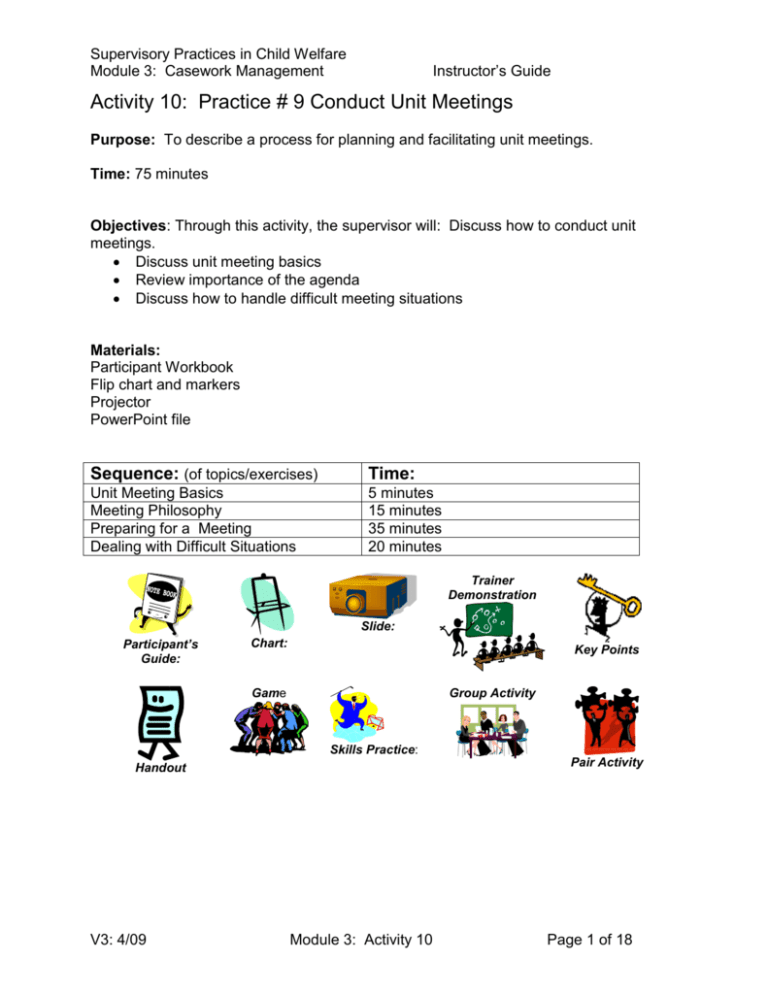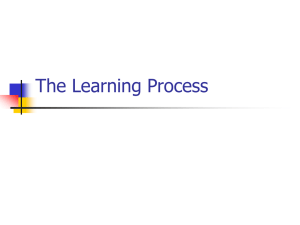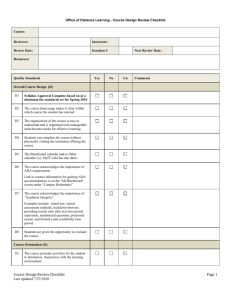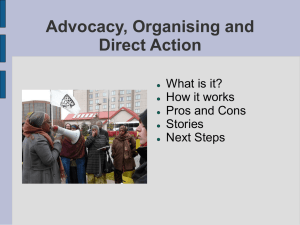Activity A11: Conduct Unit Meetings
advertisement

Supervisory Practices in Child Welfare Module 3: Casework Management Instructor’s Guide Activity 10: Practice # 9 Conduct Unit Meetings Purpose: To describe a process for planning and facilitating unit meetings. Time: 75 minutes Objectives: Through this activity, the supervisor will: Discuss how to conduct unit meetings. Discuss unit meeting basics Review importance of the agenda Discuss how to handle difficult meeting situations Materials: Participant Workbook Flip chart and markers Projector PowerPoint file Sequence: (of topics/exercises) Time: Unit Meeting Basics Meeting Philosophy Preparing for a Meeting Dealing with Difficult Situations 5 minutes 15 minutes 35 minutes 20 minutes Trainer Demonstration Slide: Participant’s Guide: Chart: Key Points Game Group Activity Skills Practice: Pair Activity Handout V3: 4/09 Module 3: Activity 10 Page 1 of 18 Supervisory Practices in Child Welfare Module 3: Casework Management Instructor’s Guide Activity 10: Practice # 9 Conduct Unit Meetings (Total Minutes 75) Method Script Tips/Notes Unit Meeting Basics 5 Minutes Welcome to Conducting Effective Meetings What makes leading a meeting different from participating in a meeting? PowerPoint Slide: Say: Ask: In the next section you’ll learn strategies for running effective unit meetings. These basics should give you the skills to leverage your meeting time and get results. What makes leading a meeting different from participating? (3-4 minutes of responses) Group Activity Say: Learner Guide: V3: 4/09 Correct! You’re in charge You must decide what to do How you’ll handle problems All of this requires planning Let me share some meeting statistics Approximately 11 million meetings occur in the U. S. each day (MCI survey). National Statistics Council reports that 37% of employee time is spent in meetings. Because we do spend a lot of time in meetings, it’s important to use that time effectively. Module 3: Activity 10 Page 2 of 18 Supervisory Practices in Child Welfare Module 3: Casework Management Instructor’s Guide George David Kieffer, author of The Strategy of Meetings shares some of his research. He talked with some of America’s leaders in both public and private organizations. He summarized two major findings: 1. The skill of managing a meeting is very important 2. Most Professionals have no real training in conducting effective meetings. Conduct Unit Meetings Purpose: • To describe a process for planning and facilitating unit meetings. Slide: Objectives: • Discuss unit meetings basics • Review importance of the agenda • Discuss how to handle difficult situations within a meeting 229 Say: Course Objectives Discuss unit meeting basics Review importance of the agenda Discuss how to handle difficult situations within a meeting Review the course objectives Learner Guide: Meeting Philosophy 15 Minutes Say: Learner Guide: The ideal meeting can be very effective if it’s well planned and executed. Unit meetings are a wonderful tool to: Remind staff of the critical mature of their work in accomplishing the agency’s mission, Discuss performance expectations including responsibilities, relationships and degree of authority in the process of identifying unit goals. S V3: 4/09 Provide positive reinforcement and reinstruction for weak areas, Follow up and reshape action plans Regular dissemination and discussion of DYFS policies and procedures, Module 3: Activity 10 Page 3 of 18 Supervisory Practices in Child Welfare Module 3: Casework Management Instructor’s Guide Recognize individual contributions to the unit’s or agency’s effort. When the meeting is over, everyone can leave the room knowing that something has been accomplished. Turn to Workbook pg. ___ Meeting Quiz Take 5 minutes to complete this quiz Learner Guide: Do: Debrief: Share with participants: Say: V3: 4/09 Complete quiz Read answers orally; Score using scale on quiz. Debrief the activity by: Reviewing the correct answers Use the scale below to rate participants’ performance. Correct Quiz Answers 1. When should you call a meeting? (B) 2. What is your objective and how do you find it? (A) 3. Should you hold meetings on a regular basis? (D) 4. Who should participate? (C) 5. What should a good agenda include? (A) 6. Is it necessary for the agenda to be distributed before a meeting? (D) 7. Is it appropriate to hold a meeting in a restaurant? (C) 8. How can you keep a meeting from running overtime? (A) 9. When do you end a meeting (B) 10. How can you best evaluate the success of your meeting? (B) Use the scoring key to the left. Ask participants’ to share and defend their answers. Quiz Results – 1. If most of your answers are incorrect, your meeting knowledge needs some attention! These questions reflect your basic meeting know-how. 2. If approx. half of our answers were correct, your meeting knowledge is average. Although you are aware of some meeting basics, you could learn more. Module 3: Activity 10 Page 4 of 18 Supervisory Practices in Child Welfare Module 3: Casework Management Instructor’s Guide 3. If most of your answers were correct, CONGRATULATIONS! Your meeting IQ is above average. You understand the basics of having an effective meeting. Continue building your meeting knowledge. Preparing for a Meeting 35 minutes Say: A meeting is conducted by a leader or facilitator. The facilitator or leader drives the meeting process Makes sure that the meeting objectives are reached Keeps the meeting moving forward. Preparation Preparation Say: The key to a productive meeting is preparation: Before scheduling a meeting, ask yourself: Is a meeting the best way to handle this? You’ll cut down on wasted meeting time and restore confidence in the group’s belief that the meetings they do attend are necessary Let’s say that we have decided that a meeting is the best way to deliver the information. The meeting process includes some basics that are useful in conducting an effective meeting. To conduct a successful meeting certain important tasks have to be completed. We’ll take time to examine each. Productive meetings begin with a purpose. You need to have a good reason for calling a meeting. It can be an expensive use of time if it’s not planned well. The Meeting Process • Purpose • Objectives • Logistics • Agenda PowerPoint Slide: V3: 4/09 • Ground Rules Module 3: Activity 10 Page 5 of 18 Supervisory Practices in Child Welfare Module 3: Casework Management Say: Instructor’s Guide Decisions such as whom to invite to the meeting, to how to run it, the meeting location, should revolve around the meeting’s purpose. For example: If your unit needs to understand a new resource practice procedure, invite the supervisor from the Resource Unit to present it to your unit. Say: Group Activity Learner Guide: V3: 4/09 The purpose of the meeting should be explained to participants in advance of the meeting. Participants need this information to adequately prepare. Also, this will satisfy idle curiosity. When workers are given adequate time to prepare for a meeting, things run smoother and time is not wasted. Reflection Exercise Let’s take a minute to reflect. Instruct the group To think of two unit meetings one good and one that needed improvement that you’ve attended in the past. Your attendance could have been either as a unit member, or as the leader/facilitator. To answer the questions found on p.____ of the learner Guide. To answer the questions without input from others. To be prepared to share with the large group. You have 10 minutes to complete your questions. What criteria did you use to rate the quality of the meetings? If you rated the meeting as negative, what was lacking? If you rated it as positive, why? What were your impressions of the leader/facilitator? If your impressions were negative, how will you ensure that your meetings will be different? Have you conducted a unit meeting that was less than you hoped? Module 3: Activity 10 Setup the activity 10 minutes has been allotted for this exercise Page 6 of 18 Supervisory Practices in Child Welfare Module 3: Casework Management Say: Say: Instructor’s Guide What response did you get from your unit? How would you rate your past performance as facilitator/leader? Are your unit meetings regularly scheduled? Did you identify the purpose of your meetings? Do not process/debri ef at this time. Reconvene the group We are going to hold off debriefing this exercise until later. Let us turn our attention to other areas of preparation for a meeting. An important step in preparing for a successful meeting is to set objectives. Ask yourself, “What is it I want to accomplish, what is my purpose. Your objectives should stem from your purpose. Purpose of Objectives… • • • • Establish the purpose Determine what is to be accomplished Identify outcomes Focus the agenda PowerPoint Slide: 235 Key Points: Meeting objectives: Establish the purpose Determine what to accomplish Identify specific outcomes Focus the agenda Identify concrete measures for evaluating the success or failure of the meeting. Helps you continuously improve the effectiveness of your meeting process As the facilitator/leader write down your specific objective and make sure that you achieve it. Logistics • Time • Location • Announcement PowerPoint Slide: • Equipment 237 V3: 4/09 Module 3: Activity 10 Page 7 of 18 Supervisory Practices in Child Welfare Module 3: Casework Management Instructor’s Guide A well planned meeting includes logistics. Learner Guide: Learner Guide: Key Points: Logistics involve Time- When Participant availability often rules Location- Where Consider the number of people who will attend Consider accommodations needs. Though most of us do not have to worry about who to invite to our unit meeting (that is within the unit) you may be responsible for planning and/or conducting a unit meeting that includes someone outside of your unit, so keep these points in mind. Announcement Send announcements to invitees at least one week in advance Send the agenda with no less than one day notice. It is important to send written announcements and reminders of the meeting to unit members. The above points are recommended but you can modify them to suit your needs. Equipment Determine equipment needs ahead of time Pencils, pens, paper audiovisual, visual aids, other materials (if showing a video, DVD, etc. Flipcharts, easels, white board, etc., for recording important points, mapping out strategies and brainstorming, etc. Strive to meet when most of your attendees are available. Understand that all may not be available because of job responsibilities. Have someone record minutes of the meeting to be shared with those who could not attend. Agenda Agenda – – – – – PowerPoint Slide: Essential to Meeting Prepares Members Keeps Meeting On Track Used to Evaluate the Meeting Used to Plan Follow Up Sessions Communicates Expectations – – – – Meeting objective Topics for discussion Meeting start and end times Discussion leader for each topic and time 238 V3: 4/09 Module 3: Activity 10 Page 8 of 18 Supervisory Practices in Child Welfare Module 3: Casework Management Instructor’s Guide Agendas Ask: Why should you have an agenda for your unit meeting? Say: Say: Answer: The agenda: Is essential to meeting Helps prepare members for the meeting Keeps the meeting on track Can be used to evaluate the meeting Can be used to plan following sessions Communicates Expectations Identifies Discussion Topics Establish start and end times Meeting objectives Meeting start and end times Discussion Leader for each topic and time Ground rules are a formal reminder of how the unit intends to work together. Meeting Ground Rules • Promote a safe environment for discussion • Contain the decision-making strategy • Allow everyone a chance to speak PowerPoint Slide: • Maintain respect for each other’s opinions • Establish rules for constructive feedback 239 Ground rules V3: 4/09 Promote a safe and nurturing environment for unit member participants by establishing and adhering to ground rules. Can contain your decision making strategy. Will decision be made by consensus, majority rule, autocratically by the leader, or by others outside of the unit? Several decision making strategies may be used in a single unit meeting. Allow everyone a chance to be heard. If necessary limit the amount of floor time for each participant. Establish and maintain respect of each other’s opinions. Module 3: Activity 10 Page 9 of 18 Supervisory Practices in Child Welfare Module 3: Casework Management Instructor’s Guide Establish rules for giving constructive feedback. As the facilitator/leader you should be open to giving and accepting feedback graciously to and from others. Key Points: As leader You should arrive early. Help enforce, the one meeting concept- no side bars. Keep participant on target. Avoid tangents. Maintain an atmosphere of respect. Focus on the idea, not the person when disagreeing. Start on time and end on time. Encourage participation. Handle difficult situations in a timely manner. Returning to the Reflection Exercise Group Activity: Do: Debrief: Ask: Say: V3: 4/09 Instruct participants to: Review the answers they recorded earlier in the reflection exercise. Evaluate whether or not to change initial responses based of our discussion. Ask several participants to share their results Debrief the exercise asking the following question How many re-evaluated their rating of a “good” or “bad” meeting? How many feel that their meeting would have been more successful if they had a purpose, agenda, ground rules, pre-meeting prep? How many still view themselves as “effective” or “ineffective” unit meeting leaders/facilitators? How many think that their unit meeting will be more productive? How many feel that they will use it back on the job? With time and preparation you too can conduct a successful unit meeting. You may not feel comfortable in your role as leader/facilitator rather than as a participant in a unit meeting but with a little effort you can turn unsuccessful meeting into successful and productive unit meetings. Module 3: Activity 10 Return to the questions in the Reflection Exercise Page 10 of 18 Supervisory Practices in Child Welfare Module 3: Casework Management Instructor’s Guide How to Handle Difficult Situations 20 minutes Say: In Module 2 we discussed dealing with conflict. Supervisors should remember the value behind the guiding principles of Preserve dignity and respect, Listening with Empathy-Be Fully Present, Find Common Ground Without Forcing Change and Honor Diversity, Including Your Own Perspective. Kindler, Herb Ph.D. Conflict Management: Resolving Disagreement s in the Workplace, 3rd edition, Crisp Fifty – Minute Series Guiding Principles • Preserve dignity and respect • Listen with empathy- Be fully present • Find common ground without forcing change • Honor diversity, including your own perspective PowerPoint Slide: 240 Say: Say: V3: 4/09 Preserve Dignity and Respect: o Keep focus on issues, not personalities. o Assume the other person is expressing a legitimate concern when disagreeing, unless otherwise proven. Listen with Empathy – Be Fully Present: o When listening to others’ views, put yourself in their shoes. See from their perspective; feel the other person’s emotional state. o When ideas conflict with the ones you hold see if you discount the speaker’s message. o When you listen with fill presence, you convey the message: “I respect you as a person. Your thoughts and feelings are important to me. Find Common Ground Without Forcing Change: In a dispute, it is tempting to force or expect others to change their behavior style or basic of ideas. But people change basic patterns only with difficulty, or where there is trust or a belief that it is in their best interest to do so. In the absence of trust or until it can be established, what helps are shared vision and agreement on common values. Module 3: Activity 10 Principle #1 Principle #2 Principle #3 Page 11 of 18 Supervisory Practices in Child Welfare Module 3: Casework Management Say: Say: Instructor’s Guide Honor Diversity, Including Your Own Perspective: o Different view points spur the creative search for resolution. When you are the lone dissenter, you may be tempted to surrender your conviction to meet those of others. But your gift to others is your independent point of view – which requires that you understand what really matters to you. Diversity holds the seeds for constructive change. Principle #4 These guidelines form an attitudinal framework helpful in resolving disagreement. With these principles, you communicate, “I honor your needs. I take responsibility for sharing my views with you. We can manage our differences constructively. But you say that you can not use the techniques because of the type of behavior that some unit members are exhibiting. Well let us take a page from professionals who confront difficult behavior on a regular basis, teachers, nurses and other medical professionals. Behaviors • • • • • • • • • PowerPoint Slide: Rambling Shyness or Silence Talkativeness Sharpshooting Arguing Grandstanding Overt hostility/resistance Griping Side Conversations 241 Behavior #1: Rambling – wandering around and off the subject. Using far-fetched examples or analogies. Learner Guide: V3: 4/09 Possible responses: o Refocus attention by restating relevant point. o Direct questions to group that is back on point. o Ask how comment(s) or topic relates to current topic or discussion. o Say: “Would you summarize your main point please?” Module 3: Activity 10 “Getting the Most out of Your AIDS/HIV Trainings,” East Bay AIDS Education Training Center, adapted from: California Nurses Association, AIDS Train the Trainer Program for Health Care Providers (1988) http://honolulu.hawaii. edu/internet/committe es/FacDevCom/guide bk/teachtip/behavior.h tm Page 12 of 18 Supervisory Practices in Child Welfare Module 3: Casework Management Instructor’s Guide Behavior #2: Shyness or Silence—lack of participation Learner Guide: Possible responses: o Give strong positive reinforcement for any contribution. o Involve by asking a question directly. Behavior #3: Talkativeness—knowing everything, manipulation, chronic whining. Learner Guide: Possible responses: o Acknowledge comments made. o Give limited time to express viewpoint or feelings, and them move on. o Make eye contact with someone else and move towards that person. o Say: “That‘s an interesting point. Now let’s see what other people think.” Behavior #4: Sharpshooting—trying to shoot down or trip you up. Learner Guide: Possible responses: o Admit that you do not know the answer and redirect the question to the group or the person who asked it. o Acknowledge that this a joint learning experience. o Ignore the behavior. Behavior #5: Arguing—disagreeing with everything you say; making personal attacks. Learner Guide: V3: 4/09 Possible responses: o Redirect question to group or supportive individual. o Acknowledge positive points. o Recognize participant’s feelings and move on. o Say: “I appreciate your comments, but I’d like to hear from someone else,” or “It looks like we disagree.” Module 3: Activity 10 Page 13 of 18 Supervisory Practices in Child Welfare Module 3: Casework Management Instructor’s Guide Behavior #6: Grandstanding—getting caught up in one’s own agenda or thoughts to the detriment of other learners. Learner Guide: Possible response: o Say, “You are entitled to your opinion, belief or feelings, but now it’s time we moved on to the next subject,” or “Can you restate that as a question?” or “We’d like to hear more about that if there is time, later. Behavior #7: Overt Hostility/Resistance – angry, belligerent, combative behavior. Learner Guide: Possible responses: o Reframe hostility as fear to depersonalize it. o Remain calm, and polite. Keep you temper in check. o Don’t disagree, but build on or around what has been said. o Always allow him/her a graceful retreat from the confrontation. o Allow the person to solve the problem being addressed. He or she may not be able to offer solutions and will sometimes undermine his or her own position. o Talk privately. Behavior #8: Griping –maybe legitimate complaining. Learner Guide: V3: 4/09 Possible responses: o Point out that we can’t change policy here. o Validate his/her point. o Indicate time pressure. o Say you will discuss the problem with the participants privately. Module 3: Activity 10 Page 14 of 18 Supervisory Practices in Child Welfare Module 3: Casework Management Instructor’s Guide Behavior #9: Side Conversations – may be related to subject or personal. Distracts group members and you. Learner Guide: Summary: Possible response: o Don’t embarrass talkers. o Ask opinions on subject being discussed. o Ask talkers if they would like to share their ideas. o Make eye contact with the talkers. o As a last resort, stop and wait. Unit meetings, when well planned can be a useful tool to help new supervisors deal with difficult situations. The key is to decide on its purpose, set an agenda, begin and end on time, handle difficult situations promptly, and maintain an atmosphere of respect for all. When you notice unproductive behavior, nip it in the bud. Manage unwanted behavior utilizing the strategies above before you become irritated, impatient or upset. Allow others a way to save face. Remind yourself that if supervising was easy, everyone would be doing it. Appendix A Behavior: Rambling – wandering around and off the subject. Using far-fetched examples or analogies. Possible responses: o Refocus attention by restating relevant point. V3: 4/09 Module 3: Activity 10 Page 15 of 18 Supervisory Practices in Child Welfare Module 3: Casework Management Instructor’s Guide o Direct questions to group that is back on point. o Ask how comment(s) or topic relates to current topic or discussion. o Say: “Would you summarize your main point please?” Behavior: Shyness or Silence—lack of participation Possible responses: o Give strong positive reinforcement for any contribution. o Involve by asking a question directly. Behavior: Talkativeness—knowing everything, manipulation, chronic whining. Possible responses: o Acknowledge comments made. o Give limited time to express viewpoint or feelings, and them move on. o Make eye contact with someone else and move towards that person. o Say: “That‘s an interesting point. Now let’s see what other people think.” Behavior: Sharpshooting -- trying to shoot down or trip you up. Possible responses: o Admit that you do not know the answer and redirect the question to the group or the person who asked it. o Acknowledge that this a joint learning experience. o Ignore the behavior. Behavior: Arguing—disagreeing with everything you say; making personal attacks. Possible responses: o Redirect question to group or supportive individual. o Acknowledge positive points. o Recognize participants feelings and move on. o Say: “I appreciate your comments, but I’d like to hear from someone else,” or “It looks like we disagree.” V3: 4/09 Module 3: Activity 10 Page 16 of 18 Supervisory Practices in Child Welfare Module 3: Casework Management Instructor’s Guide Behavior: Grandstanding—getting caught up in one’s own agenda or thoughts to the detriment of other learners. Possible response: o Say, “You are entitled to your opinion, belief or feelings, but now it’s time we moved on to the next subject,” or “Can you restate that as a question?” or “We’d like to hear more about that if there is time, later. Behavior: Overt Hostility/Resistance – angry, belligerent, combative behavior. Possible responses: o Reframe hostility as fear to depersonalize it. o Remain calm, and polite. Keep you temper in check. o Don’t disagree, but build on or around what has been said. o Always allow him/her a graceful retreat from the confrontation. o Allow the person to solve the problem being addressed. He or she may not be able to offer solutions and will sometimes undermine his or her own position. o Talk privately. Behavior: Griping –maybe legitimate complaining. Possible responses: o Point out that we can’t change policy here. o Validate his/her point. o Indicate time pressure. o Say you will discuss the problem with the participants privately. Behavior: Side Conversations – may be related to subject or personal. Distracts group members and you. Possible response: o Don’t embarrass talkers. V3: 4/09 Module 3: Activity 10 Page 17 of 18 Supervisory Practices in Child Welfare Module 3: Casework Management o o o o V3: 4/09 Instructor’s Guide Ask opinions on subject being discussed. Ask talkers if they would like to share their ideas. Make eye contact with the talkers. As a last resort, stop and wait. Module 3: Activity 10 Page 18 of 18









